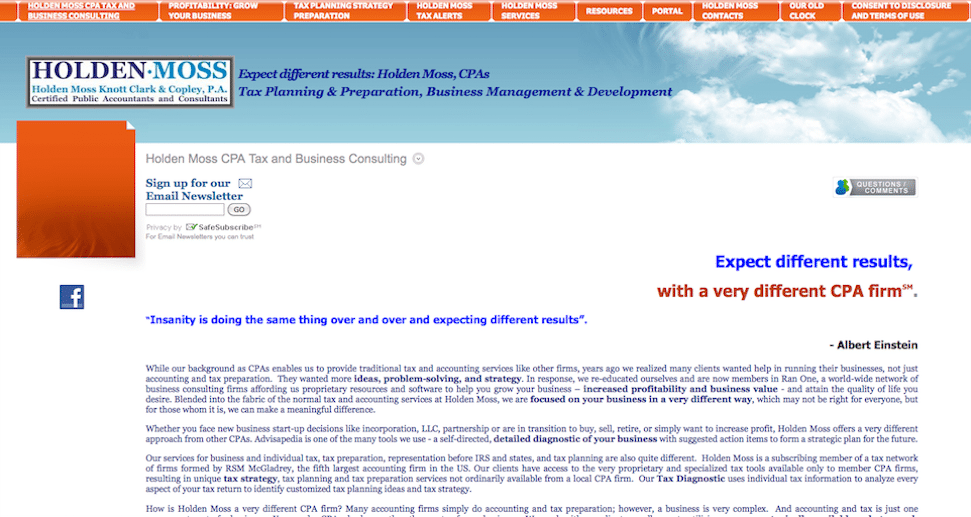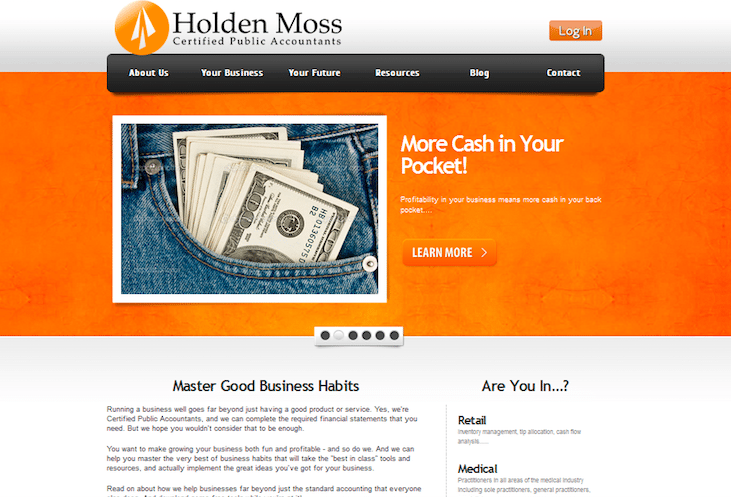Following last week’s blog about how to turn your website visitors into customers, by now you should have your own copy of ‘Don’t make me think’ by Steve Krug and have maybe even read a couple of chapters. If not, have a read through some of these quick tips which you can use to get visitor insight and help turn your accountancy firm website visitors into customers:
1. Focus on the big picture: What’s your number one?
A conversion to a sale or a call into your business development team is far more valuable than getting people to simply download your latest e-book, so concentrate on that. Is your number one action having someone pick up the phone and call you? Is it that they arrange an appointment? If so, big obvious telephone numbers or a simple and clear contact form will help this conversion.
Your other smaller conversions (like downloading an ebook, or watching a webinar) then support your ultimate goal. If you identify that 20% of the people who download your ebook will call in to your sales team within 30 days, then making that conversion path nice and simple will support your “number one”.
2. What’s in it for your prospect?
Nobody is interested in what you do, only what you can do for them.
All of your website pages will have a page header, the biggest bit of text that tells your visitors what they can expect from you, your business and why they should contact you. So make sure it highlights the benefit to the reader. During a three way split test on different headline types, it turns out that headlines that focused on the benefit to the reader performed better every time. (What a surprise.)
To give you an example of what I mean have a look at Holden Moss’ old home page.
It tells you they are accountants, to ‘expect different results’ (what does that even mean?), and then gives you loads and loads and loads of text to work through. Yawn.
But since then, we’ve given them a new homepage. Compare the difference.
Yes, I want more cash in my pocket, yes I want to improve my business habits. These headlines speak to me regardless of whether I’m an individual, a business owner and regardless of which sector I’m in.
3. Get the point across in 3 seconds. Or less.
Think about how you use the internet. When you need something you Google it, skim the results, click what you think might be right, skim the web page, maybe click a link or most likely you’ll not see anything and you’ll be scrabbling for the back button.
You have about 3 seconds to encourage someone to take action when they land on your website, if they don’t know what to do then they’ll be disappearing back to Google and possibly to one of your competitors. So be very clear about what you want people to do when they arrive and make it the biggest call to action. Remember people don’t read copy online they skim and seek relevance to their need.
This is how not to do it:
As a side note, this is ‘how not to do it’ if you want people you don’t know to take action immediately. This kind of page can work great for repeat visitors/customers/clients who know the site and how it works and come there every day. That’s not what we’re talking about here.
4. Crazy Egg
Wouldn’t it be awesome if you could see exactly what people saw on your website and where they were actually clicking on each of your pages? Well Crazy Egg can show you. This unbelievable software can be added to your website and will show you precisely where people are clicking on your website, what buttons they see and which things they just ignore. This is a great way to see actual user behaviour on your website from the comfort of your office chair.
5. Ask your Nan. Or parent. Or even your kids.
Seriously. Sit her (or them) down and ask her to find a few specific pages on your website or take a specific action that you want your visitors to complete and just watch. Now obviously you can’t show/tell or cajole her to the goal you want otherwise what do you learn? Just observe what she does and note where things go wrong or where she gets stuck or lost. If your grandmother/grandfather ‘gets’ your website and is able to intuitively navigate around and complete the things that you want, then you are getting there. Chances are that she’ll get lost, ask you some questions along the way and spend way to long on irrelevant pages. This is all CRO gold.
Write down the questions you get asked during the process, you need to answer these not just for your Nan but for all the other people that visit your website without the benefit of an accountant sitting next to them. When you have some questions or issues that are clearly an issue, fix them. Ta da, you just conducted website usability testing and have some optimisation improvements for your website based on user feedback.
6. Buy some Pizza
This is my favourite way to make any website better and I normally do it every 3 months or so. You have a set of questions that you asked your Nan, or following the outcomes of that exercise probably some different questions or scenarios, so go and ask some more people.
When budgets are tight, formal usability testing with eye tracking and double negative control groups are not possible. £50 worth of pizza and 6-8 willing people will give you more insight and value than you have probably ever had from your website.
You can either ask people in your business who don’t use your website regularly, but if most people are familiar with your website then you might not get much value. For some really honest and interesting feedback why not ask a few friendly clients? Get half a dozen friendly clients in a room for some free lunch explain that you want some honest feedback on your website and that you’ll need about 20-30 minutes each of their time.
In terms of conducting the test, you will need two rooms, one for testing and one for pizza, ideally some screen capture software you can use Goto meeting or Camtasia so you don’t have to scribble down infinite notes and that’s about it. Obviously if you have a couple of rooms that allow you to conduct two tests at the same time then you can save time or use more people.
Aside from the usability insight you will get, there are many fringe benefits to this exercise. You get to strengthen relationships, network and create introductions across your client base, highlight different products or services via the testing plus it’s also an interesting and unique way to position you and your business as forward thinking and customer oriented. I’ll bet that after the session your clients will head straight back to their own offices and set up their own usability pizza parties! You are now a business thought leader in your clients head.
There is one thing you need to remember. People are nice and will worry about telling you the truth, indeed you might not enjoy the potentially rough feedback you might get on y our beloved website. But just remember, they and you are testing the website, not you or your ability to do what you do. Be very clear with yourself and your testers that only genuine honest answers are valuable and that they can be as brutal as they want so you can make the user experience on your website better for everyone in the future.



